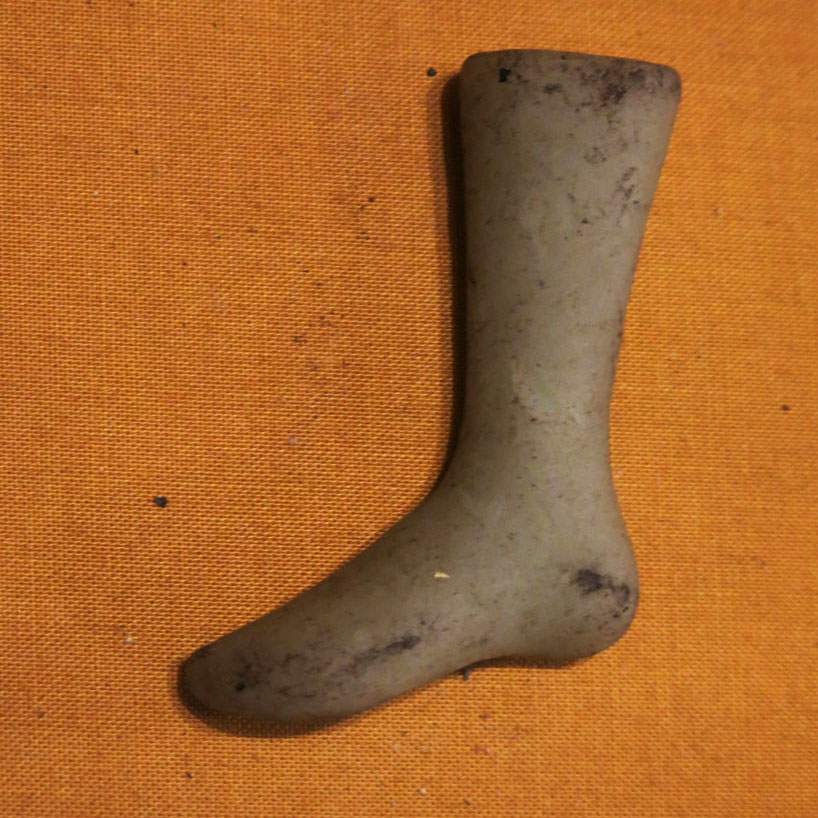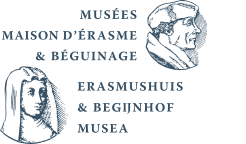
The unusual objects No. 6

A vow for a miracle: ex-votos, items of the people’s devotion While
While the Beguinage remains closed for renovation, Erasmus House is putting an unusual object from the municipal museums’ vast historical, archaeological, folk art and religious collections on display each month. Five ex-votos are on display this month.
1. Anatomical ex-voto of a pair of eyes
Wax votive figurine representing two eyes.
Belgium, end 19th century
Wax
4,3 x 9 cm Inv. BEG 5909
2. Anatomical ex-voto of a leg
Wax votive figurine representing a leg
Belgium, end 19th century
Wax
6,4 x 4,2 cm Inv. BEG 5918
3. Anatomical ex-voto of a nose afflicted by rhinorrhoea
Metal votive figurine representing a runny nose
Belgium, end 19th century
Metal
6,8 x 4,4 cm Inv. BEG 5907
“[V]ows, through which something is promised to God…” is how the 13th century theologian Saint Thomas Aquinus (Summa Theologiae, Part 2-2, Q88) introduces the subject of votum, a pagan practice that was taken over by the Church at the start of Christianity (according to Erasmus). The materialisation of such vows as objects or money offered to a specific saint are called ex-votos, from the Latin ex-voto suscepto (from the vow made). These votive objects could take many forms – paintings of saints, engravings of thanks, wax objects representing diseased limbs, and so on – with lit candles in church being the most widespread today.
The ex-voto ritual
According to Roman Catholic rites, the wishes must be made in a holy place and the believer must deserve this action of grace through an effort, gift, pilgrimage, or some commitment or restriction that s/he places on her/himself. Two categories of ex-voto are recognised: propitiatory ex-votos, which accompany the request for help, and gratulatory ex-votos to thank the intercessor for her/his mediation. Ex-votos are never addressed to God or Jesus Christ directly, but to the Virgin Mary or a particular saint, depending on the latter’s “specialisation”. So, Saint James the Greater is invoked to cure rheumatism, Saint Sebastian for protection against plague, and Saint Guy, the patron saint of Anderlecht, to combat dysentery and livestock diseases. Moreover, a saint who fails to deliver will quickly lose her/his worshippers. Ex-votos were mass produced but could be customised (precious metals, refinement, etc.); the cost and quality of the object were directly correlated with the magnitude of the service requested.
Erasmus House ex-votos
The wax anatomical ex-votos that you see here represent miniaturised limbs or extensions of the devotee’s body, sometimes in an idealised form, and either healthy or afflicted by ills, that were given in supplication for divine action or in thanks after healing. They include a heart, eyes, a leg with varicose veins, and a runny nose and were probably made before the end of the 19th century, at which point ex-votos took the form of engravings of thanks. Many ex-votos of the past have since disappeared, with the most valuable ones having been melted or smelted down and re-used.
Five ex-votos are on display this month in the Erasmus House
Research and text
Meggy Chaidron
Acknowledgements
Zahava Seewald
Céline Bultreys
Anne Deckers







